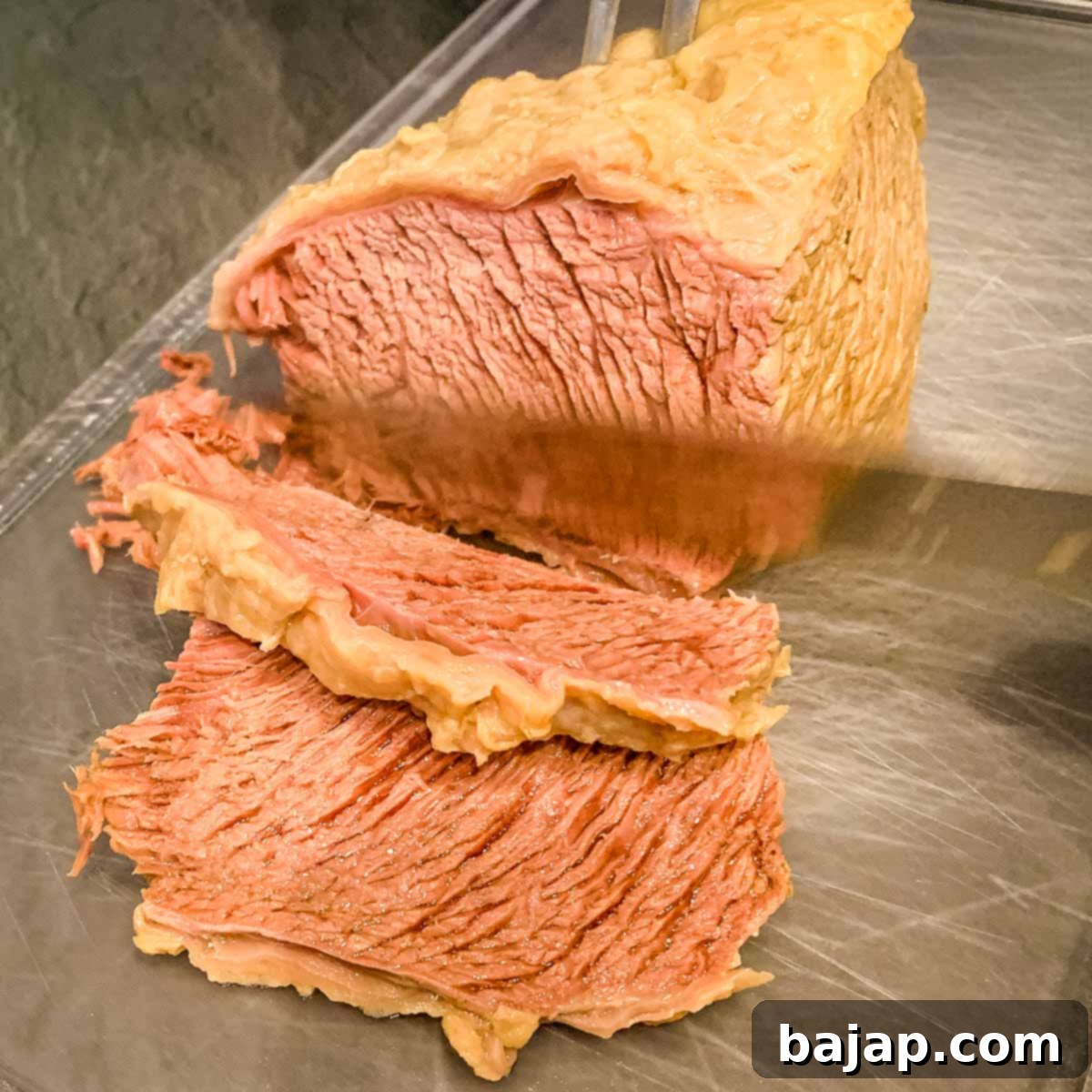Tafelspitz: Master Austria’s Classic Boiled Beef – An Authentic Viennese Recipe
Embark on a culinary journey to the heart of Austria with one of its most revered and delicious national dishes: Tafelspitz. More than just “boiled beef,” this exquisite dish is a true Viennese delicacy, celebrated for its incredibly tender meat, rich broth, and a delightful array of traditional accompaniments. Perfect for a festive holiday meal, a special dinner party, or simply a comforting family gathering, Tafelspitz promises a memorable dining experience. Today, we’ll guide you through preparing this authentic masterpiece right in your own kitchen.
Often hailed as the flagship dish in some of Vienna’s most prestigious restaurants, such as the renowned Plachutta in Wollzeile, Tafelspitz carries a legacy that dates back to the imperial courts of Emperor Franz Joseph I. This recipe allows you to recreate that regal experience, bringing a taste of Austrian tradition to your table. Prepare to impress your guests and savor the rich flavors of this timeless dish.
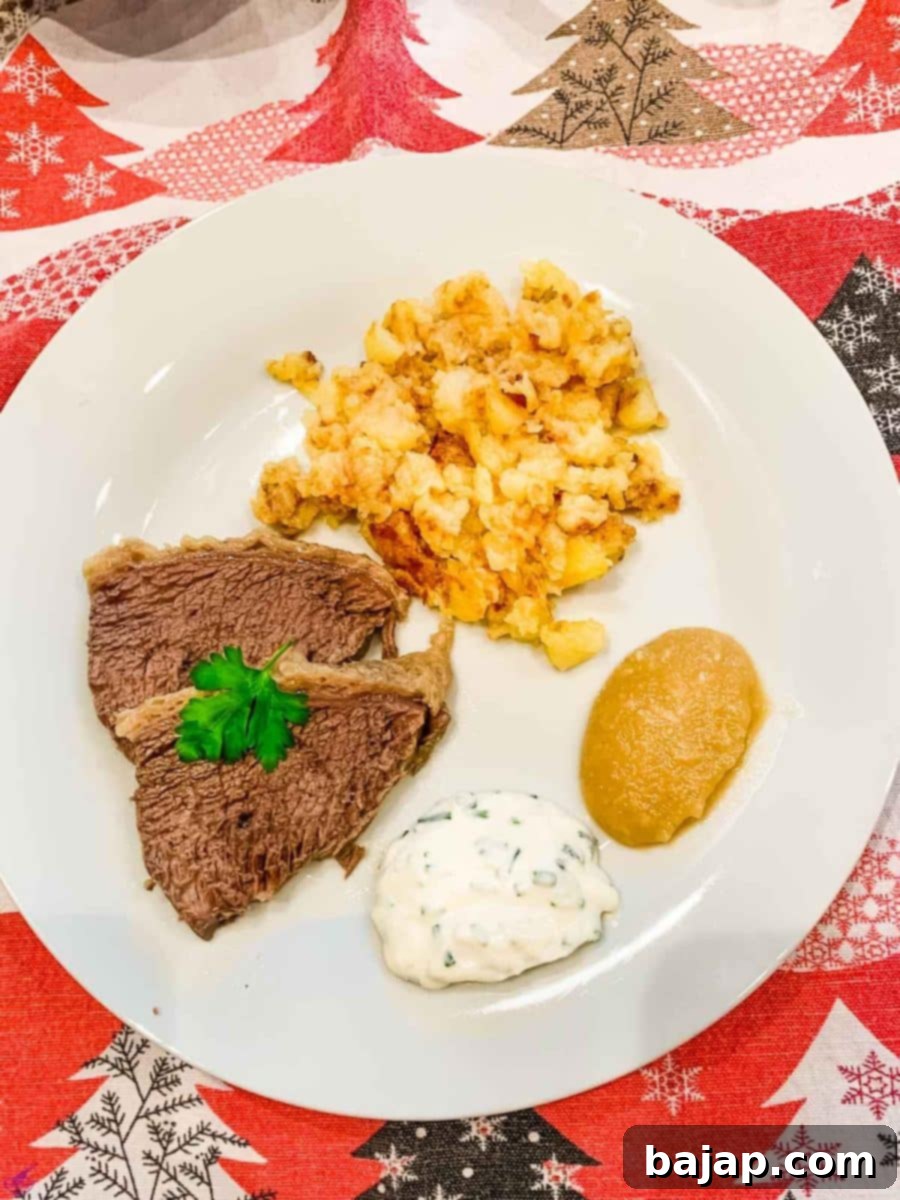
The History and Essence of Tafelspitz
Tafelspitz, meaning “tip of the table” or “top piece,” refers to a specific cut of beef – the hindquarter’s flat end of the rump, tapering to the tail. What makes this cut perfect for the dish is its medium-to-long fibrous structure and, crucially, a characteristic layer of fat on one side. This fat is essential for moisture, flavor, and tenderness. If the cut lacks this fat, it’s not true Tafelspitz!
The dish gained its legendary status as a favorite of Emperor Franz Joseph I, making it a staple of traditional Viennese cuisine. The secret to its unparalleled tenderness lies in the slow, gentle simmering process, which transforms a tough cut into a melt-in-your-mouth experience. Unlike a standard beef broth where the goal is to extract all flavor from the meat into the liquid, with Tafelspitz, the primary aim is to preserve the incredible flavor and succulence within the beef itself, while still creating a delicious accompanying broth.
When you order Tafelspitz in Vienna, especially at a renowned establishment like Plachutta, you’ll experience a meticulously prepared meal. The succulent beef is typically served with its flavorful broth in a small soup pot, presented alongside an array of traditional side dishes. It’s truly a culinary ritual to savor.
🥘 Ingredients
To create this authentic Viennese prime boiled beef, gather these essential ingredients:
- Mirepoix: A classic mix of soup vegetables including carrots, parsley root, celery stalk, and leek. These will infuse your broth with aromatic depth.
- Tafelspitz: The star of the show. Aim for a high-quality cut of approximately 1.3 lbs (600g). As mentioned, this is the flat end of the beef rump with a distinct fat layer. Its fibrous nature makes it ideal for long, slow simmering.
- Salt: Essential seasoning for both the broth and the beef.
- Peppercorns: Whole peppercorns add a subtle, fragrant heat to the broth.
- Lovage: This herb is a traditional addition to Austrian broths, providing a unique savory, celery-like flavor.
- Stock Cube: A quality beef or vegetable stock cube can enhance the richness of your broth. See on Amazon.
- Garlic Cloves: For a pungent, savory undertone.
- Onion: A quarter of an onion, sometimes charred (see tip below), adds depth and a beautiful golden color to the broth.
See the recipe card below for exact quantities.
🍽 Equipment
You’ll need a few basic kitchen tools for this recipe:
- Large Soup Pot with at least 7-quart capacity – crucial for simmering the beef and broth.
- Cutting Board – for preparing vegetables and slicing the cooked beef.
- Kitchen knife – a sharp one makes all the difference.
- Strainer – for separating the broth from the vegetables and other solids.
🔪 Instructions for Authentic Tafelspitz
Follow these steps carefully to achieve a tender, flavorful Tafelspitz, just like in Vienna:
- Prepare the Broth Base: Begin by filling a large soup pot about two-thirds full with cold water. Add all the mirepoix (carrots, parsley root, celery stalk, leek), salt, peppercorns, lovage, stock cube, garlic cloves, and a quarter of an onion. For an extra layer of flavor and a beautiful golden hue to your broth, you can char the onion half lightly on a dry pan before adding it to the pot.
- Bring to a Boil: Bring this mixture to a rolling boil over high heat. This initial boiling allows the vegetables and spices to release their flavors into the water, creating a rich aromatic base for your beef.
- Add the Tafelspitz: Once the water is vigorously boiling, carefully add the Tafelspitz beef. The crucial step here is to add the meat to already boiling water. This quickly seals the exterior of the beef, helping to trap its natural juices and incredible flavor inside the meat. This is a key distinction from preparing a traditional beef broth, where you might start the meat in cold water to extract its flavor *into* the soup. For Tafelspitz, we want the beef itself to be the star.
- Skim and Simmer: As the water returns to a boil with the meat, you may see some foam or impurities rise to the surface. Gently skim these off with a ladle to ensure a clear broth.
- Slow Simmer to Perfection: Reduce the heat to a gentle simmer. Place the lid on the pot, slightly ajar, to allow some steam to escape. Let the Tafelspitz cook slowly for approximately 2.5 to 3 hours, or until the meat is incredibly soft and fork-tender. This slow simmering process is vital for breaking down the connective tissues and achieving that characteristic melt-in-your-mouth texture.
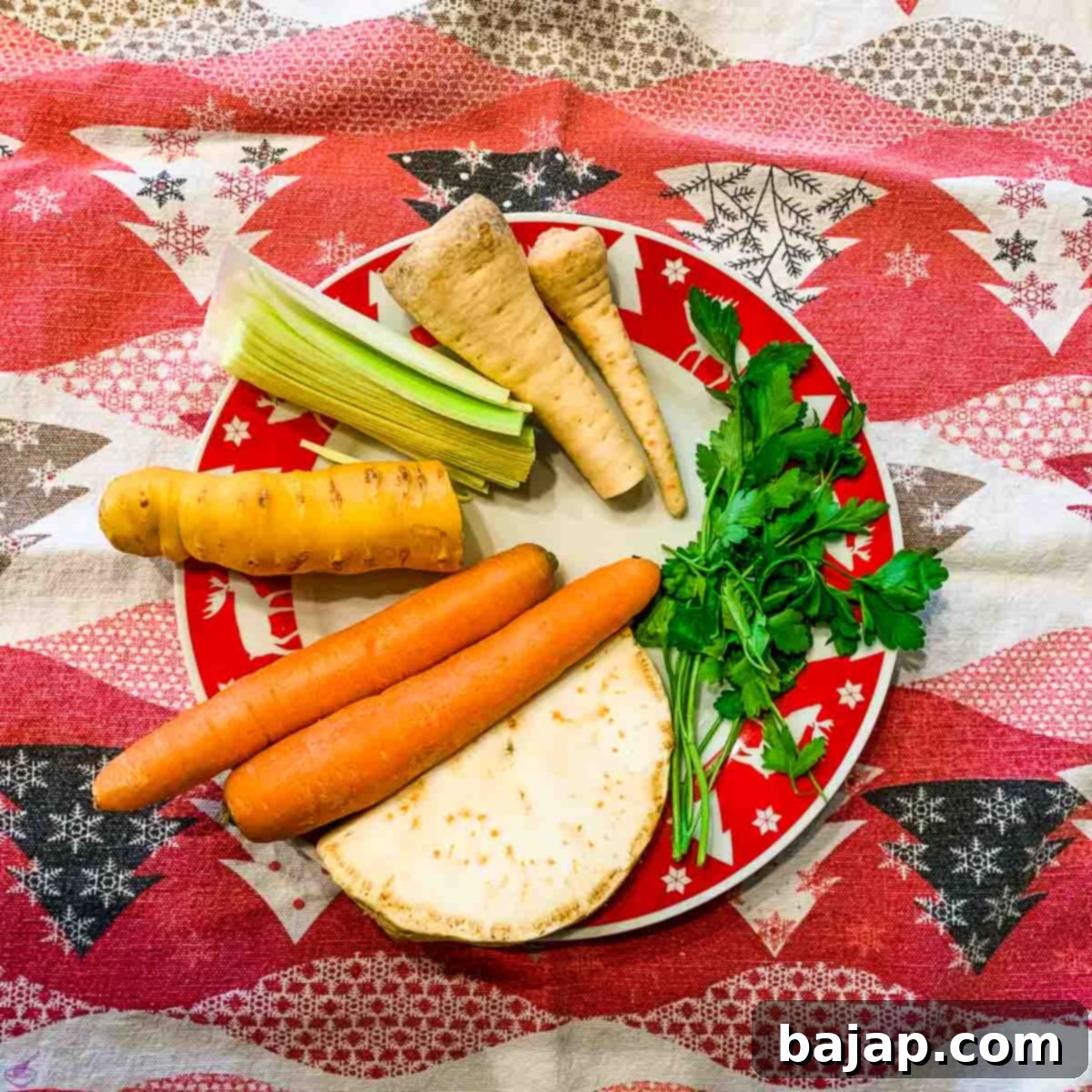
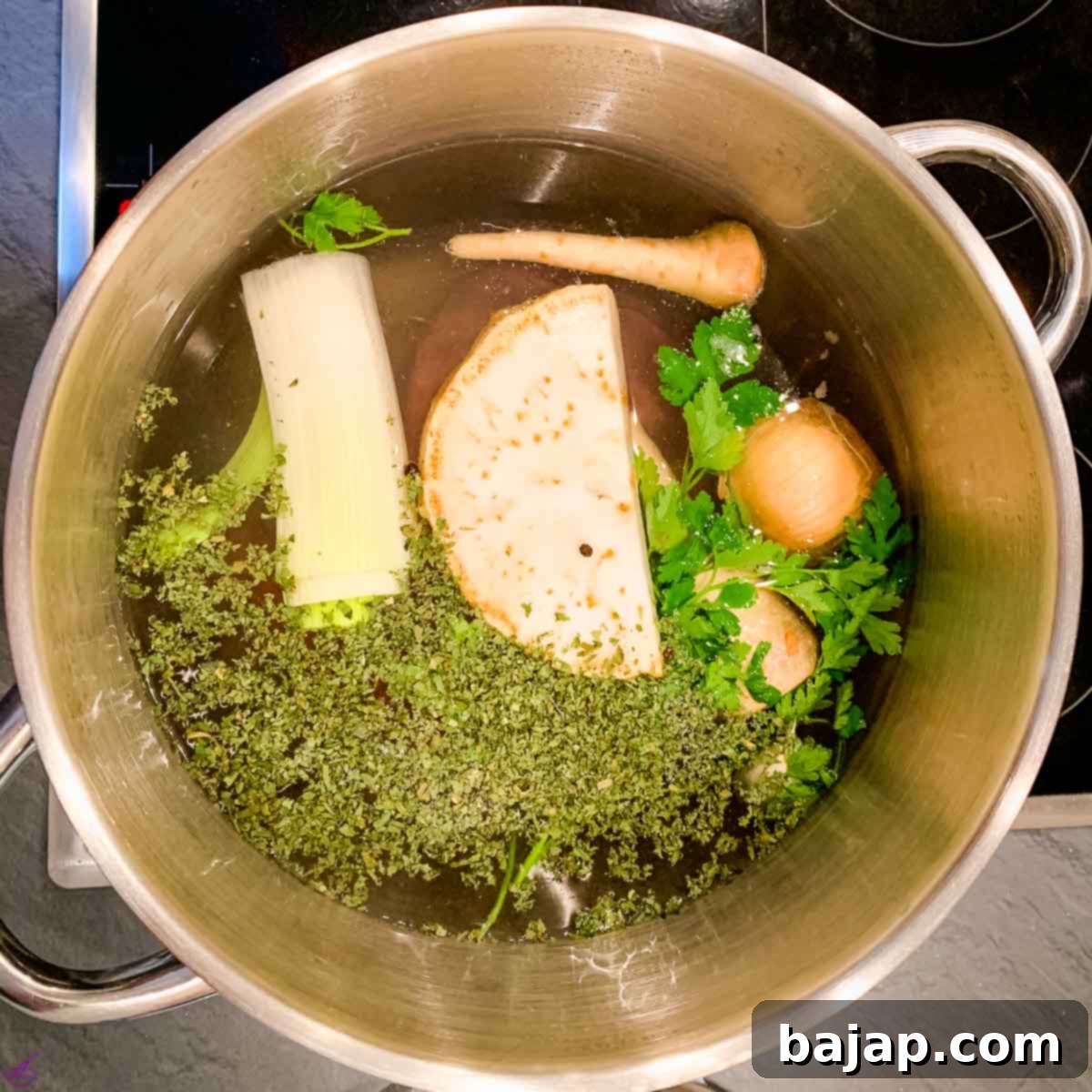
- Strain the Broth: Once the beef is cooked, carefully remove it from the pot. Strain the entire broth through a fine-mesh sieve into another pot or heatproof container. Discard the spent vegetables, or save the carrots if you wish to serve them with the soup.
- Rest and Slice the Meat: Place the cooked Tafelspitz on a cutting board and allow it to rest for a few minutes. This helps redistribute the juices, ensuring maximum tenderness. Then, using a sharp knife, cut the meat into finger-thick slices, typically against the grain for optimal texture.
- Prepare Carrots (Optional): If you saved the carrots from the mirepoix, slice them and return them to the strained soup for extra flavor and substance.
- Serve the Broth: The rich, clear beef broth is traditionally served as a starter course before the main meat dish. You can serve it as is, or with your choice of garnish. Popular Austrian additions include fine noodles, frittatas (savory pancakes cut into strips), liver dumplings, or semolina gnocchi.
- Present the Tafelspitz: Finally, arrange the sliced Tafelspitz beautifully on a platter or individual plates. Serve it immediately with classic Austrian accompaniments: roasted potatoes (Erdäpfelschmarrn), a vibrant apple horseradish (Apfelkren), and a creamy chive sauce.

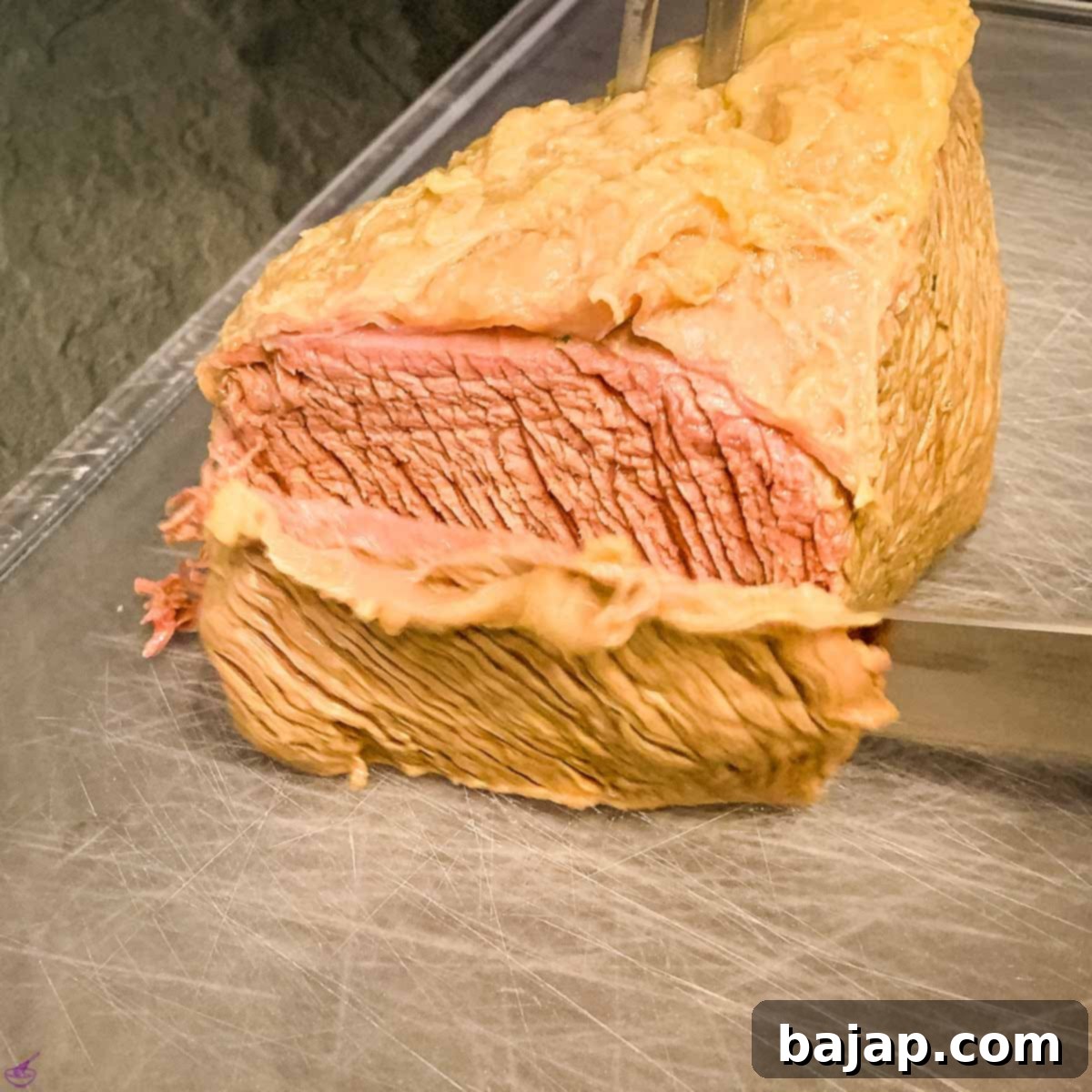
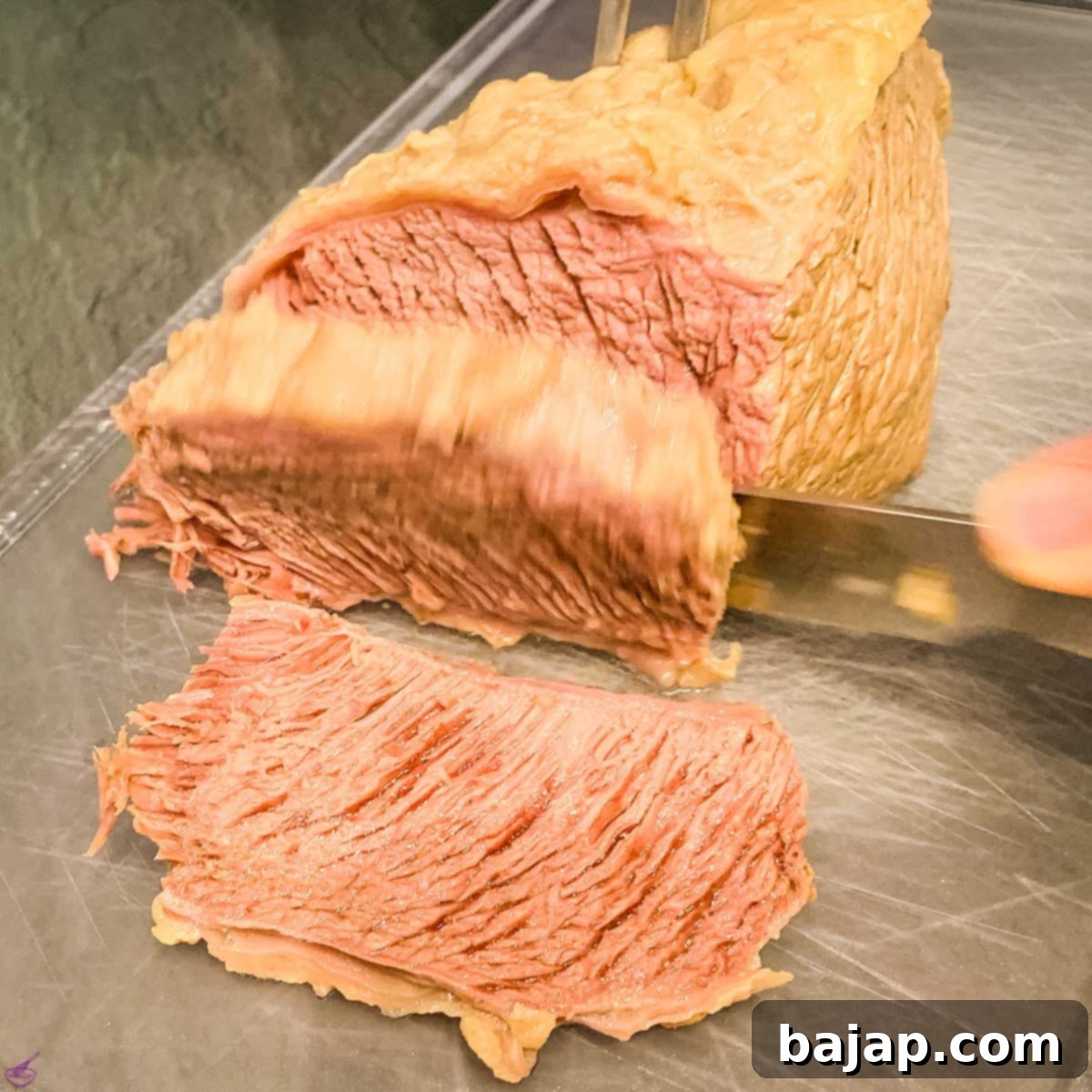
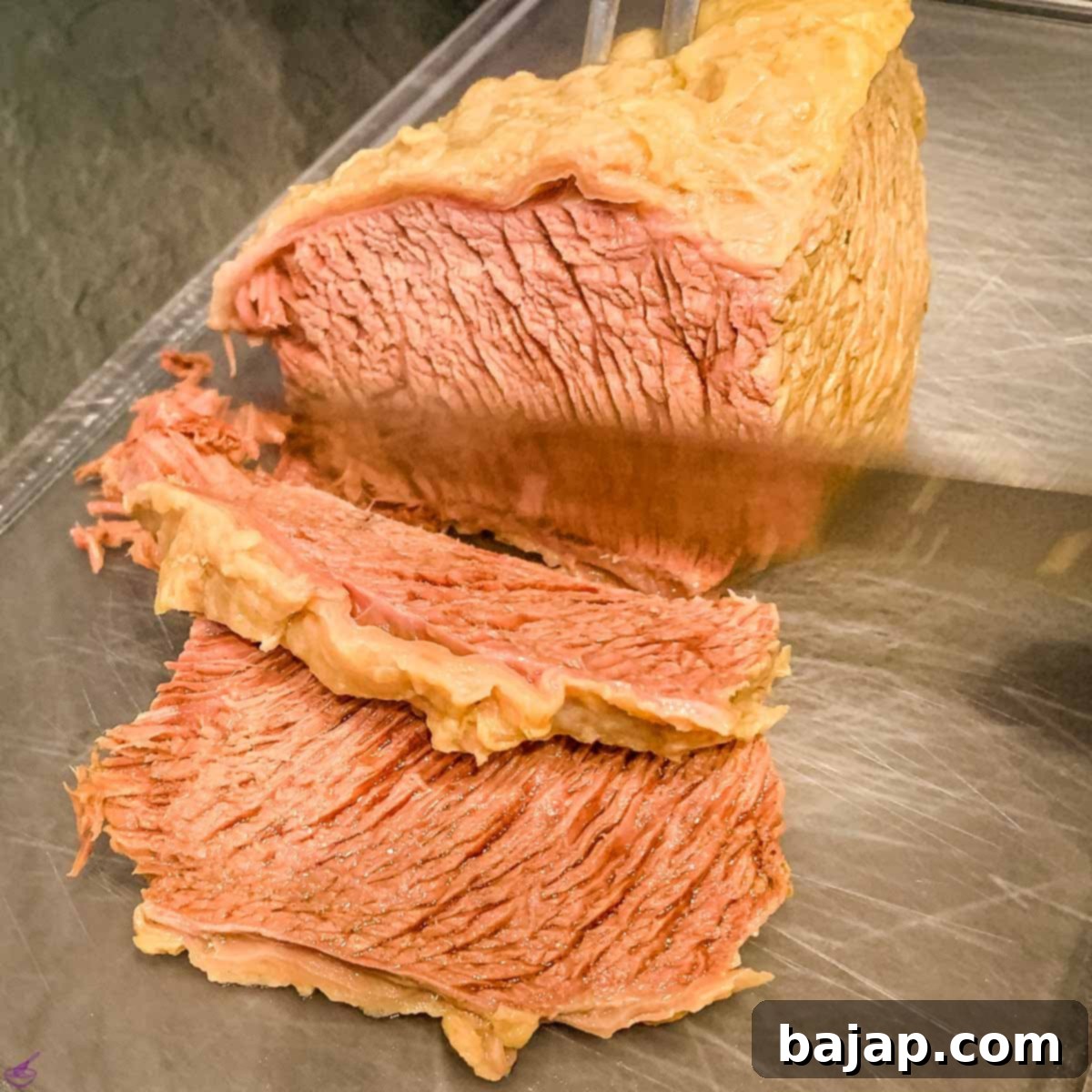
🇦🇹 If you are looking for more authentic Austrian recipes, you can find them in our Austrian recipe category. 🇦🇹
💭 Top Tips for the Perfect Tafelspitz
Traditional Accompaniments with Austrian Boiled Beef
Understanding how Tafelspitz is traditionally served in Austria is key to replicating the authentic experience. When dining out, the meat is often brought to the table submerged in its clear, rich soup within a small, elegant soup pot. The main accompaniments, such as Kartoffelschmarrn (roasted potatoes), Apfelkren (apple horseradish), and Chive Sauce, are typically served separately, allowing diners to customize each bite. In some variations, creamed spinach might replace the roasted potatoes, offering a different but equally delicious texture. For the broth itself, guests often choose a garnish in advance, with popular options including delicate noodles, hearty liver dumplings, or light frittata strips (shredded savory pancakes). Don’t forget to season with a pinch of salt and pepper to taste!
🙋🏻 Frequently Asked Questions
Vienna’s best for boiled beef is undoubtedly Plachutta Wollzeile! It’s an iconic establishment known for perfecting Tafelspitz. I can highly recommend Plachutta to anyone seeking an authentic and high-quality experience.
The traditional accompaniments for Tafelspitz include Erdäpfelschmarrn (roasted potatoes), a creamy Chive Sauce, and a zesty Apple Horseradish Sauce. These three elements create a harmonious balance of flavors and textures with the tender beef.
Tafelspitz is a specific cut from the beef hindquarter. It forms the flat end of the beef rump, often tapering towards the tail. This particular cut is characterized by its medium to long fibers and, crucially, a layer of fat on one side, which contributes significantly to its flavor and tenderness when simmered. It’s perfectly suited for simmering, cooking, and braising due to its composition. Have fun cooking and enjoying this traditional Viennese delicacy! Let me know how you liked it!
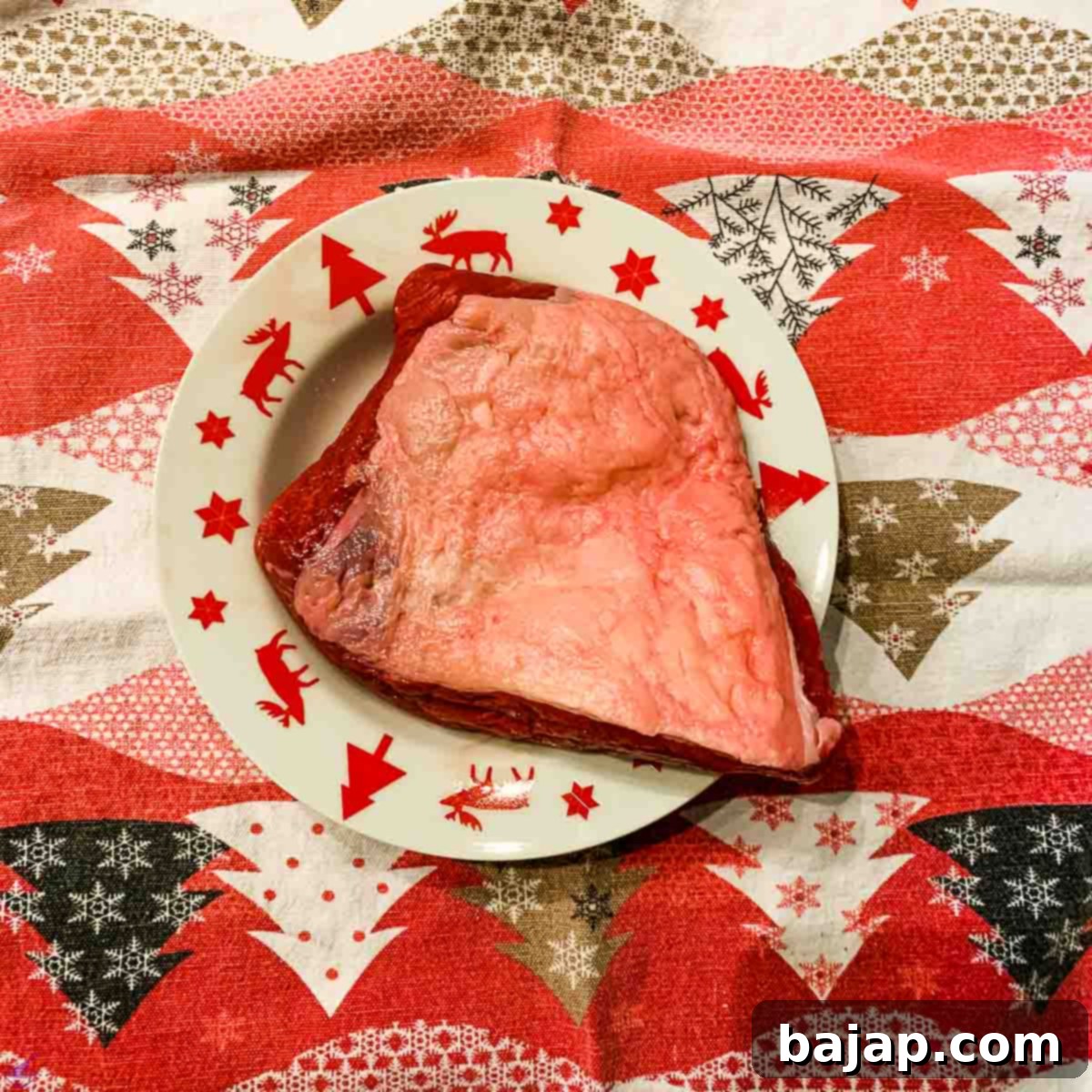
How long can you keep cooked beef?
According to the USDA, cooked beef should be used within 3 to 4 days if kept refrigerated at 40°F (4°C) or less. Refrigeration effectively slows, but does not entirely halt, bacterial growth. This recommendation applies to most cooked leftovers.
It’s important to understand the two main types of bacteria that affect food: pathogenic bacteria and spoilage bacteria. Pathogenic bacteria are responsible for foodborne illnesses and can multiply rapidly within the “Danger Zone” – a temperature range between 40°F (4°C) and 140°F (60°C). Crucially, these bacteria often do not alter the taste, smell, or appearance of food, making their presence undetectable without testing.
Spoilage bacteria, on the other hand, can grow even in cold temperatures, such as those in a refrigerator. Over time, they cause food to develop undesirable odors, tastes, and textures, which typically lead people to discard the food. While most spoiled food won’t necessarily make you sick, some pathogenic bacteria, like Listeria monocytogenes (Lm), are capable of thriving in cold environments and can cause illness if consumed. Microbial spoilage results from the activity of bacteria, molds, and yeast.
While spoilage is primarily a matter of food quality, it also has implications for food safety. It is crucial never to taste foods to determine if they are safe to eat. The Danger Zone (41°F to 140°F / 5°C to 60°C) is where bacteria multiply rapidly. To prevent food from entering this zone, always keep cold foods at or below 40°F (4°C) and hot foods at or above 140°F (60°C). The USDA advocates following their FOUR steps to Food Safety – Clean, Separate, Cook, and Chill – to minimize food spoilage and reduce the risk of foodborne illnesses.
Source: ask.usda.gov
📖 Recipe: Tafelspitz – Austrian Prime Boiled Beef
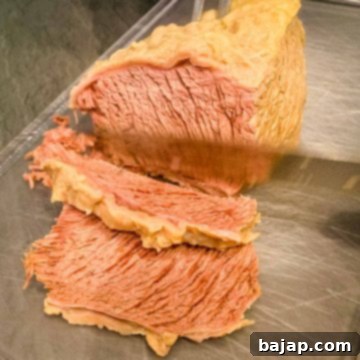
Tafelspitz – Austrian Prime Boiled Beef
Recipe by Nora
Save Recipe
Saved!
Pin Recipe
Equipment
-
Large Soup Pot
-
Cutting Board
-
Kitchen knife
-
Strainer
Ingredients
- 1 bunch Mirepoix
- 1.3 lb Tafelspitz Tafelspitz is part of the beef hindquarter. It forms the flat end of the beef rump, tapering to the tail.
- 1 teaspoon salt
- 8 pcs peppercorns
- 1 teaspoon lovage
- 1 stock cube
- 1-2 cloves garlic
- ¼ Onion
Instructions
-
Fill a large soup pot ⅔ full with water.
-
Add all the other ingredients (except the meat) and bring the water to a boil.1 bunch Mirepoix, 1 teaspoon salt, 8 pcs peppercorns, 1 teaspoon lovage, 1 stock cube, 1-2 cloves garlic, ¼ Onion
-
Once the water boils, add the meat and let it cook for 2.5 hours. Put the lid of the pot at an angle during this process.1.3 lb Tafelspitz
-
After 2.5 hours strain the soup to separate it from the greens.
-
Place the cooked Tafelspitz on a cutting board and slice it into finger-thick slices.
Notes
Use the cooked soup right away as an appetizer.
Now you can serve the soup with an addition of your choice. (I opted for a noodle soup here). You can also use frittatas, liver dumplings, semolina gnocchi, here. Whatever you fancy.
What to serve with Tafelspitz?
- Erdäpfelschmarrn (roasted potatoes)
- Chive Sauce
- Apple Horseradish Sauce
Nutrition values are estimates only, using online calculators. Please verify using your own data.

🇦🇹 You Might Also Like Authentic Austrian Flavors
- How to Make Apfelkren – Austrian Horseradish Sauce
- How to Make Delicious Homemade Chive Sauce in 5 Minutes
- Fresh Strawberry Sponge Cake
- Austrian Erdäpfelschmarrn – Grated Pan-Fried Potatoes
⛑️ Food Safety Guidelines
Ensuring food safety is paramount when preparing any meal. Please keep these guidelines in mind:
- Cook beef to a minimum internal temperature of 165 °F (74 °C) to ensure it is safe for consumption.
- Always use separate utensils for raw meat and cooked food to prevent cross-contamination.
- Thoroughly wash your hands after handling raw meat or any raw ingredients.
- Avoid leaving cooked food out at room temperature for extended periods. Refrigerate promptly.
- Never leave cooking food unattended on the stovetop or in the oven.
- When frying, opt for oils with a high smoking point to avoid the formation of harmful compounds.
- Ensure good ventilation in your kitchen, especially when using a gas stove, to prevent the buildup of fumes.
For further comprehensive information on safe food handling, please refer to the FDA’s Safe Food Handling guidelines.
